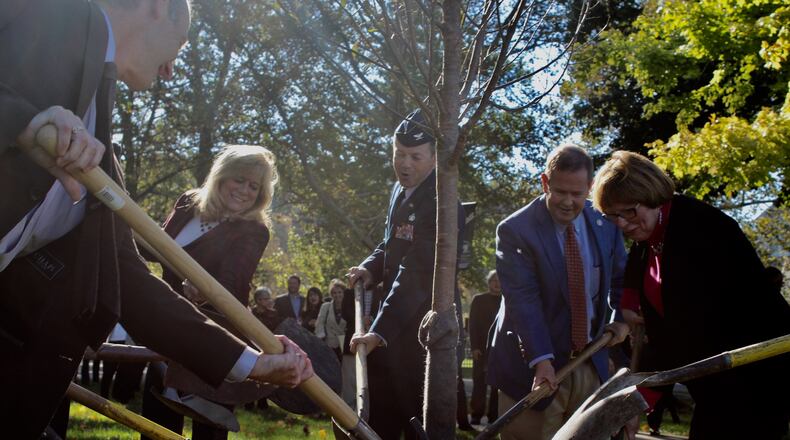Operation 1000 Cherry Tree celebrated the planting of its 1,000th and 1,001st trees on Thursday as part of a special ceremony at Carillon Historical Park.
RELATED: Dayton has lost 40 percent of tree cover since 1982
Local resident Alex Hara, a Japanese-born businessman, was the driving force behind the effort, which he launched in 2012 to thank the U.S. military, U.S. citizens and this region for helping provide relief following the devastating earthquake and tsunami in Japan the prior year.
“This community will soon become known for cherry blossoms,” Hara said.
Operation 1000 Cherry Trees has planted the colorful, flowering trees all across the region, including about 35 in recent months alongside of the section of the Great Miami River between the Dayton Art Institute and Carillon Historical Park.
MORE: Nickel a pill: Mayor Whaley’s prescription painkiller surcharge plan
In May, an urban “cherry blossom trail” was established alongside the river, and 100 cherry trees planted in the Gateway Park area were paid for by Dayton Power & Light and granted to the city.
The trail of cherry trees will connect the art museum and historical park and will help counter Dayton’s shrinking tree canopy, local leaders said.
The Dayton Daily News last year reported that the city of Dayton has lost about 43 percent of its tree cover on public property since 1982 (or about 26,440 trees). About 30 percent of the city is covered in trees.
MORE: Popular tax incentives could be history: What it would mean for Dayton
The planting of 1,000 cherry trees symbolizes goodwill among countries and the project has and will continue to beautify the Dayton region for generations to come, said Dan Foley, Montgomery County commissioner, at the ceremony.
The Operation 1000 project affirms the friendship between Japan, the United States and Ohio, said former Ohio Gov. Bob Taft who served as the project’s honorary chairman.
In addition to their beauty, cherry trees also are good for the community because they don’t threaten to interfere with power lines, which can lead to power outages, said Tom Raga, president and CEO of DP&L.
Cherry trees, which line the streets of the nation’s capital, cost about $300 each. There’s also planting and maintenance costs.
Hara moved to Dayton in 1979 and has been a community leader who has helped expand cross-cultural relations between the U.S. and Japan, said Mitsuhiro Wada, consulate general of Japan in Detroit.
Montgomery County is home to 16 facilities belonging to Japanese companies, which employ more than 3,000 people, and 127 Japanese nationals live in Dayton, Wada said.
Hara shows that one person can make a huge difference in the community and can create a lasting legacy, said Michael Parks, president of the Dayton Foundation, which helped establish a special fund for the project.
“You’ve been persistent, you’re caring, you’re humble and you have a vision and you have a love of the Miami Valley,” Parks told Hara.
About the Author

